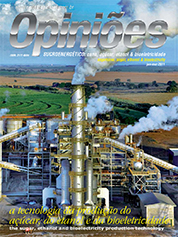Jorge Petersen
Director of Petersen Engenharia
Op-AA-27
Reception, feeding and sugarcane preparation
In the 1970’s and 1980’s, only whole stalk sugarcane was processed, burnt in the fields, in a harvest that lasted six to seven months and reached a production of approximately 1.5 million tons (350/400 tons of sugarcane per hour). In the years 2000 to 2010, one began processing sound chopped sugarcane, without burning it in the fields, using mechanized harvesting, reaching an hourly crushing rate of about 800 to 1,200 tons of sugar.
In the beginning, feeding the sugarcane was done using primitive solutions, such as single and combined feeding tables in the cane reception area, with inclination angles of 6° to 15° maximum, and at times, even made of wood. In the 1970’s, one began installing larger combined tables, with up to 50°, having as one objective the efficient washing of whole stalk burnt sugarcane, with less water consumption in comparison with the old tables.
Another objective achieved with larger feeding tables was to place the whole stalk sugarcane on the metallic conveyor, i.e., more homogenously, with cane density on the metallic conveyor between 280 and 300 Kg/m3, much higher than the previous density of 175 Kg/m3.
Seeking to achieve better performance of the shredder in processing sound or burnt whole sugarcane, currently what one uses are feeding tables with angles of up to 50º, equipped with a cane leveler to regulate the cane mat on the metallic conveyor and a cane thickener, installed in the upper part of the table’s driving shaft, subsequently to the leveler.
One thus obtains the chopping of the whole stalk sugarcane fed from the table into the metallic conveyor, and an errorless and more homogenous feeding, resulting in more efficient automation of the entire reception, feeding and preparation, with less power consumption, eliminating the need for the first cane knives set on the metallic conveyor. This procedure warrants a proven increase in crushing between 15 and 20%.
With the installation of feeding tables with angles of up to 50º, and widths of 13/14 meters, the process of receiving the whole stalk and chopped cane takes place on the same table. The operation is performed by means of a mechanical unloader hillo, with a capacity of 40, 50 or 60 tons, powered by an electric motor and speed reducer.
With respect to water, the environmental protocol is causing radical changes, to eliminate mineral and vegetal impurities (ground soil, sand, straw) from cane, showing the importance of the dry cleaning system that uses blowers, applicable to whole stalk or chopped, burnt or sound cane. Straw will be sent for cogeneration, along with bagasse in the last three roller mill.
With respect to preparation, in the 1970’s, sugarcane was chopped and defiberized only with light sets of sugarcane knives, with a low rate of open cell shredding. With the introduction in Brazil of new knife and hammer concepts by Deon Hullet, Tongaat and Maxcel, major innovation began in these operations.
At that time, to drive cane knives and shredders, one used low pressure vertical steam engines. In the years 2000 to 2010, high pressure steam turbines or electric motors came on stream – the latter on a grand scale. The modernization of the drives was necessary to improve performance of the shredders, for the purpose of increasing the open cells rate to about 92 to 94%.
In installations with short tandems of mills, performing good preparation may overcome difficulties in extracting juice at high grinding rates, to the point of being considered another three rollers mill set. When expanding existing units and implementing new projects, I recommend investments be made based on the cost-benefit ratio as the main criterion, while always viewing the chosen option as being definitive rather than palliative.
We have seen cases in which new mills start up already experiencing problems concerning the balance of primary operational functions, causing bottlenecks that will cost dearly to be done away with, while seeking to reach the overall balance between equipment and phases of the production process.




